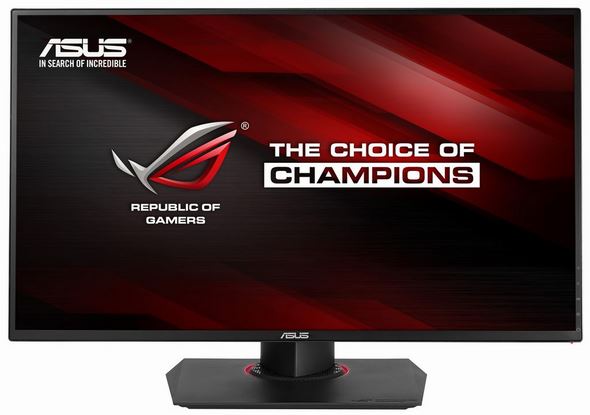ASUS ROG SWIFT PG278Q G-SYNC Monitor Review
Introduction and Specifications
Before we dive in and show you the brand-new ASUS ROG Swift PG278Q G-Sync enabled monitor, we have a confession to make: We are ecstatic that there is finally some innovation happening in the monitor market. For years, 30” panels with native resolutions of 2560x1600 and paltry 60Hz refresh rates remained the pinnacle of desktop displays, while the rest of the market filled up with cheap, less-than-stellar 1080p panels. As much as we all loved our 30” panels around here, it got a little boring staring at the same screen for years on end, especially when all of the hardware around it was evolving at a breakneck pace.
Thankfully, this past year has seen the arrival of 4K displays, with much higher resolutions and pixel densities, and NVIDIA G-Sync enabled displays that offer high refresh rates that are well beyond mainstream displays. The ASUS ROG Swift PG278Q is one of the latter, but along with G-Sync support it also packs in some other desirable features that may make this the ultimate monitor for hardcore gamers. At least for now.
Take a look at the specifications below and then we’ll dive in a little deeper and explain why the ASUS ROG Swift PG278Q is so darn good...
|
|
Display |
|
|
Panel Size (diagonal) |
27" (68.5 cm) Wide Screen (16:9) |
|
Display Viewing Area (HxV) |
596.74 x 335.66mm |
|
Panel Backlight / Type |
WLED / TN |
|
Display Surface |
non-glare |
|
Color Saturation |
72% NTSC |
|
True Resolution |
2D mode : 2560 x 1440 (up to 144Hz) |
|
Pixel Pitch |
0.233 mm (109ppi) |
|
Brightness |
350 cd/m² (max.), 300 cd/m² (typical) |
|
Contrast Ratio (Max.) |
1000:1 |
|
Viewing Angle |
170°(H) /160°(V) |
|
Display Colors |
16.7M |
|
Response Time |
1ms (Gray to Gray) |
|
Video Features |
|
|
NVIDIA G-SYNC Technology |
Yes |
|
Trace Free Technology |
Yes |
|
Color Temperature Selection |
4 modes |
|
HDCP |
Yes |
|
3D Technology |
NVIDIA 3D Vision 2 |
|
GamePlus |
Yes ( Crosshair / Timer) |
|
Ultra Low Motion Blur (ULMB) |
Yes |
|
Input / Output |
|
|
Connectors |
DisplayPort 1.2, USB3.0 ports (Upstream x 1, Downstream x 2) |
|
Power |
|
|
Power Consumption |
<90W (E.S 6.0) / <0.5W (Power Saving / Off) |
|
Voltage |
100–240V, 50 / 60 Hz |
|
Mechanical Design |
|
|
Chassis Colors |
Matt black |
|
Tilt (angle) |
+20° ~ -5° |
|
Swivel (angle) |
+60° ~ -60° |
|
Pivot (angle/direction) |
90°(clockwise) |
|
Height Adjustment (mm) |
0~120 mm |
|
VESA Wall Mounting (mm) |
100 x 100 mm |
|
Dimension / Weight |
|
|
Phys. Dimension (WxHxD) |
619.7 x 362.96 x 65.98 mm |
|
Weight |
7.0Kg(Net), 10.5Kg (Gross) |
Find the ROG Swift PG278Q and other ASUS LCD Monitors @ Amazon.com
There’s a lot to digest in the table above, but we’ll call out some of the more noteworthy items. First is the ASUS ROG Swift PG278Q’s size and resolution. This monitor is packing a 27” panel with a native resolutions of 2560x1440, which equates to a pixel density of about 109ppi. We’re not dealing with the same kind of ultra-high pixel densities as some recently-released 4K panels, but 1.8 megapixels on a 27” panel is nothing to sneeze at. In fact, with all of the growing pains associated with pixel scaling in Windows, some could argue that lower resolutions are still the way to go.
The ASUS ROG Swift PG278Q also offers a super-fast 1ms GtG response time, and a refresh rate as high at 144Hz. The panel is LED backlit and is of the TN variety. On some levels, TN panels are not quite as good as IPS or IGZO panels, since they don’t always offer quite the same viewing angles and/or color accuracy, but we have to say the particular panel used in the ASUS ROG Swift PG278Q is probably the best TN panel we’ve laid eyes on.
Brightness on the ASUS ROG Swift PG278Q is rated for up to 350 cd/m², it has a 1000:1 contrast ratio, and it can display up to 72% of the NTSC color gamut. Other features include support for G-Sync, a ULMB (ultra low motion blur) mode, HDCP, color temperature selection, and everything else you’d expect for a high-end display, save for inputs. The ASUS ROG Swift PG278Q packs only a single DisplayPort input, which is necessary to support G-Sync.








